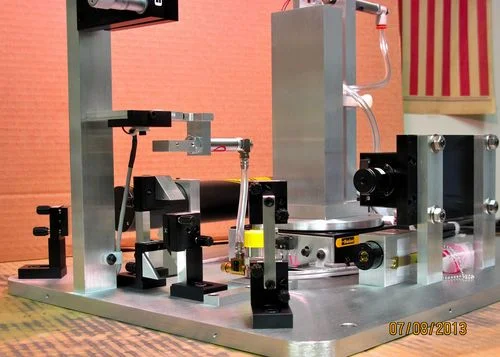Spectroscopic Measurements of Index Vs Wavelength (Dispersion)
Multiple-wavelength operation is available for Metricon’s Model 2010/M to provide rapid and accurate curves of thin film and bulk material dispersion (index vs wavelength) similar to the results from a spectroscopic ellipsometer.
If index is measured at three or more wavelengths a complete index vs wavelength (dispersion) curve can be easily generated in just a few seconds using the built in Cauchy fitting software embedded in the 2010/M’s control software:
Fig. 1. Cauchy dispersion curve of GaN on sapphire from measurements at 446, 532 and 633 nm
The fit equation is provided, and for wavelength ranges in the visible, Vd and Ve Abbe numbers are calculated and displayed and the user can also select up to six default wavelengths for which index is automatically calculated (index is calculated at a single wavelength, 589 nm, in the above example).
In addition, for materials with index 2.0 or less, Metricon’s new MetriconFit software allows extremely accurate determination of continuous index vs wavelength data from Model 2010/M measurements of index at just a few discrete wavelengths. For example, measurements at only three wavelengths, 405/473/635 nm or 635/980/1550 nm, can provide highly accurate dispersion curves over the 405-635 or 635-1550 nm ranges. For materials with index up to ~2.0, the worst case fitting error for these fits is less than .00006 (and for most materials and wavelengths fitting error will be much less than .00006). A fitting error of .00006 means that the fit adds no more than .00006 to the typical Model 2010/M measurement error of .0001-.0002 and, as a result, calculating index at any intermediate wavelength is only slightly less accurate than actually using a laser to measure the sample at that wavelength.
Fig. 2. Maximum MetriconFit error vs sodium D line index for 244 tested glass and crystalline test materials.
Fig. 2 above was generated by generating MetriconFit dispersion curves from refractive index values at 405, 473 and 633 nm for 244 test materials - the entire Schott and Ohara glass catalogs plus a few crystalline materials for which very accurate dispersion data is available. Index for all 244 materials was then calculated by MetriconFit at 5 nm intervals and compared to the original data and the worst case error is shown plotted against the sodium D line index of the test materials. Worst case fitting error generally increases as index of the test materials increases but is still less than .00006 for all materials. Data shown is for the 405/473/633 nm fit but results are similar for 633/980/1550 fit.
MetriconFit software is also available to determine index over the 405-1000 nm range from index measurements at four wavelengths (405, 473, 633 and 980 nm), and over the 405-1550 nm range from index measurements at five wavelengths (405, 473, 633, 980 and 1550 nm).
For those wishing to provide their own fitting software, measured index-wavelength pairs can also be easily copied from the Model 2010/M control software and pasted into a user’s own fitting software.
For users wishing to use their own laser sources, the 2010/M is also available with a port for user-supplied lasers, and with suitable dichroic beamsplitters to combine beams onto a single path, a single port can be used with several wavelengths.



